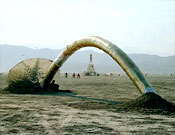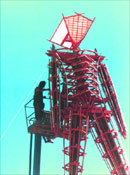The cost of producing Burning Man is not readily apparent to the average participant. Participants often receive a newsletter or a ticket and Survival Guide in the mail — the cost of mailing such materials amounted to $52,000 in 2001 — or they may read an issue of the Black Rock Gazette or the What Where When guide distributed at our gate. The total cost of printing these and other publications in 2001 was $90,000. Most participants use a portable toilet while attending the event — the installation and servicing of toilets for a population of 27,000 people costs $307,000 — and, if they become dehydrated or injure themselves, they may receive emergency medical treatment. This year we paid our emergency medical service provider nearly $140,000. Everyone witnesses the Man — the construction of this statue, its pedestal, and the fire protection beneath it cost $37,000 — and nearly everyone experiences some of our large-scale theme art. In 2001, grants for a portion of this theme art amounted to $270,000. These are tangible things that immediately affect each individual. When added together, however, these costs represent a sum of $896,000 — less than one-fifth of our overall expenditures. This is because most of our costs are incurred off-playa or behind the scenes. Many occur well before our event begins or long after everyone has returned home. Considered in their entirety, these expenditures represent a year’s worth of organization and expenditures.

The largest overall category in this financial summary is people. Fifteen staff currently work year-round to administer Burning Man. This group holds the primary responsibility for supervising and coordinating every aspect of our organization. We begin our year immediately after the event by debriefing each department. Weekly staff meetings recommence, and it is during this period that we craft a budget, plan our ticket schedule, evaluate job performance and vendor relations, reorganize our departments, devise new political strategies, and create new policies, goals and timelines to guide the efforts of paid and volunteer staff members during the coming year. This work is labor intensive and it involves many complex responsibilities. Written reports are submitted by our departments and reviewed each week. More importantly, members of the administrative staff meet with many other staff members and volunteers and interact with hundreds of participants.
As the year proceeds, we engage in a parallel planning process with government officials, process thousands of tickets, produce Burning Man’s annual newsletter and other publications, organize several public events in San Francisco, negotiate contracts with outside vendors, monitor the organization’s income and expenditures each month, continually update data bases, develop content for the Burning Man’s web site and extranet projects, revise our general staff manual, conduct volunteer and management training sessions, oversee Burning Man’s legal and political affairs, plan Black Rock City’s infrastructure, and oversee the development of our properties in Nevada. In addition, five members of this administrative group are also responsible for managing the affairs of particular departments. This is a very partial list of tasks and responsibilities, but it does begin to explain why working “full time” for Burning Man often involves working considerably more than forty hours each week. In 2001, the cost of supporting the year-round staff who labor to oversee this was $607,000– slightly more than one-tenth of our total expenditures.

A greater amount of money was paid to people involved in seasonal operations. This category includes independent contractors who provide specialized services, including skilled workers retained by our Department of Public Works. During the three months preceding our event, this team steadily increases, reaching a peak of nearly 200 (including volunteers) during August. DPW represents the largest human resource expenditure (food, shelter, compensation, etc.) for any department of Burning Man. This category also includes fees paid for cybernetic engineering, the planning and running of our worker commissary, the operation of our gate, and Ranger management.
Our largest single item of expenditure in 2001 was $502,000 paid to the Bureau of Land Management. It is a regulatory tax that is levied on us for the use of public land. When it is added to the $290,000 we currently pay in payroll taxes, state taxes, licensing fees, and federal income taxes, the total we pay to the government is $792,000. This exceeds the cost of our full-time administrative staff. It also far exceeds the cost of services provided us by the government. Little room is left for what would normally be called profit. This year we managed to retain approximately $100,000 after all our expenses were met. Since Burning Man is not supported by investors and has never borrowed money from an institution, we hope to place this money aside: to save it the old-fashioned way as security for the future.
Another major category of expenditure includes the costs of equipment rental. In 2001, this amounted to $372,000. It would cost us far less over time if we owned this equipment, but such a scale of capital investment is beyond our means. This year we were able to invest $274,000 in assets in the form of a few vehicles, trailers, buildings and heavy equipment. We also spent $72,500 for the purchase of land in Nevada. For the time being, however, we will continue to rent much of the equipment that we use to produce the event. It should also be noted that in 2001 Burning Man gave $41,000 in charitable donations to the town of Gerlach, our neighbor in the Black Rock Desert. Most of our participants pass through Gerlach on the way to Burning Man. This money is derived from ice sales. It was contributed to Gerlach Senior Citizens Center, Gerlach Volunteer Fire Department, Gerlach High School, the Gerlach Water Tower Restoration Fund, the Jeremy Williams Scholarship Fund and the Nevada Humane Society.

The preceding costs represent more than three-fifths of our expenditures in 2001. The remaining costs include such things as fire safety services, law enforcement services, insurance, bank fees, legal fees, auto and transportation expenses, meals for our workers, and dozens of truck loads of materials and supplies that create our Work Ranch and city infrastructure. In the Financial Chart, these costs are spread out amongst several categories.
This list of costs is very general — our annual itemized budget takes up many pages — and actual sums have been rounded for this report. All amounts are preliminary. These figures have been prepared prior to final closing accounting entries and the preparation of the 2001 tax returns. However, it does help to tell the story of an organization that has struggled to survive, just as every participant in Burning Man must struggle to survive.
We have learned to be self-reliant and fiscally prudent. But we have also learned that our greatest resource isn’t money. If the many gifts that participants contribute to Burning Man were expressed as expenditure, the sum would easily exceed our budget — and this is what connects us to a community. Burning Man is not a product and our goal is not to profit. We spend our money to create a world in which what’s valuable is not determined by the cost of things.

